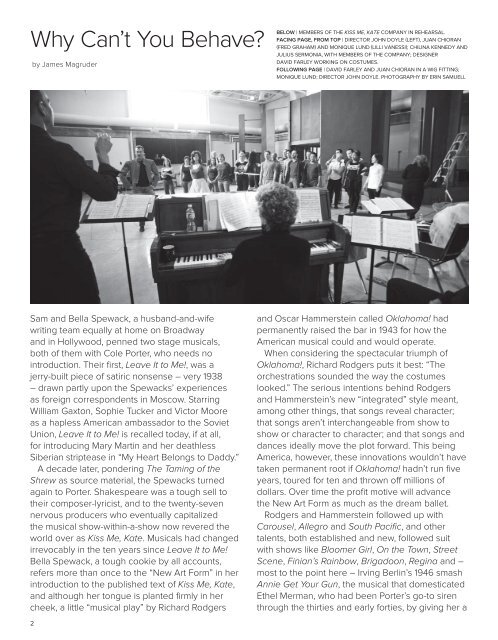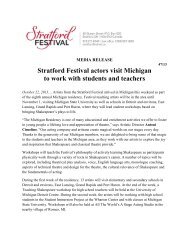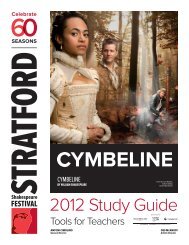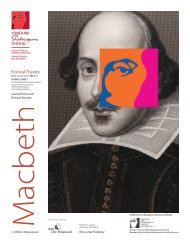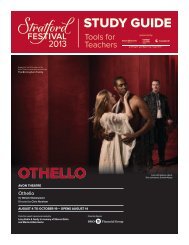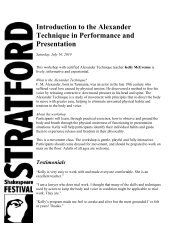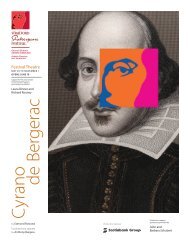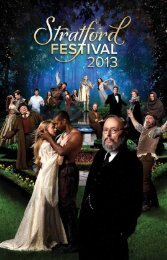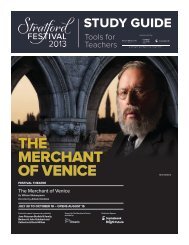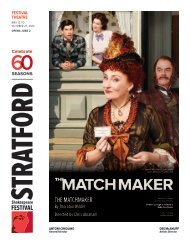Kiss Me Kate.indd - Stratford Festival
Kiss Me Kate.indd - Stratford Festival
Kiss Me Kate.indd - Stratford Festival
Create successful ePaper yourself
Turn your PDF publications into a flip-book with our unique Google optimized e-Paper software.
Why Can’t You Behave?by James MagruderBelow | <strong>Me</strong>mbers of the <strong>Kiss</strong> <strong>Me</strong>, <strong>Kate</strong> company in rehearsal.Facing page, from top | Director John Doyle (left), Juan Chioran(Fred Graham) and Monique Lund (Lilli Vanessi); Chilina Kennedy andJulius Sermonia, with <strong>Me</strong>mbers of the Company; DesignerDavid Farley working on costumes.Following page | David Farley and Juan Chioran in a Wig Fitting;Monique Lund; Director John Doyle. Photography by Erin SamuellSam and Bella Spewack, a husband-and-wifewriting team equally at home on Broadwayand in Hollywood, penned two stage musicals,both of them with Cole Porter, who needs nointroduction. Their first, Leave It to <strong>Me</strong>!, was ajerry-built piece of satiric nonsense – very 1938– drawn partly upon the Spewacks’ experiencesas foreign correspondents in Moscow. StarringWilliam Gaxton, Sophie Tucker and Victor Mooreas a hapless American ambassador to the SovietUnion, Leave It to <strong>Me</strong>! is recalled today, if at all,for introducing Mary Martin and her deathlessSiberian striptease in “My Heart Belongs to Daddy.”A decade later, pondering The Taming of theShrew as source material, the Spewacks turnedagain to Porter. Shakespeare was a tough sell totheir composer-lyricist, and to the twenty-sevennervous producers who eventually capitalizedthe musical show-within-a-show now revered theworld over as <strong>Kiss</strong> <strong>Me</strong>, <strong>Kate</strong>. Musicals had changedirrevocably in the ten years since Leave It to <strong>Me</strong>!Bella Spewack, a tough cookie by all accounts,refers more than once to the “New Art Form” in herintroduction to the published text of <strong>Kiss</strong> <strong>Me</strong>, <strong>Kate</strong>,and although her tongue is planted firmly in hercheek, a little “musical play” by Richard Rodgersand Oscar Hammerstein called Oklahoma! hadpermanently raised the bar in 1943 for how theAmerican musical could and would operate.When considering the spectacular triumph ofOklahoma!, Richard Rodgers puts it best: “Theorchestrations sounded the way the costumeslooked.” The serious intentions behind Rodgersand Hammerstein’s new “integrated” style meant,among other things, that songs reveal character;that songs aren’t interchangeable from show toshow or character to character; and that songs anddances ideally move the plot forward. This beingAmerica, however, these innovations wouldn’t havetaken permanent root if Oklahoma! hadn’t run fiveyears, toured for ten and thrown off millions ofdollars. Over time the profit motive will advancethe New Art Form as much as the dream ballet.Rodgers and Hammerstein followed up withCarousel, Allegro and South Pacific, and othertalents, both established and new, followed suitwith shows like Bloomer Girl, On the Town, StreetScene, Finian’s Rainbow, Brigadoon, Regina and –most to the point here – Irving Berlin’s 1946 smashAnnie Get Your Gun, the musical that domesticatedEthel <strong>Me</strong>rman, who had been Porter’s go-to sirenthrough the thirties and early forties, by giving her a2


